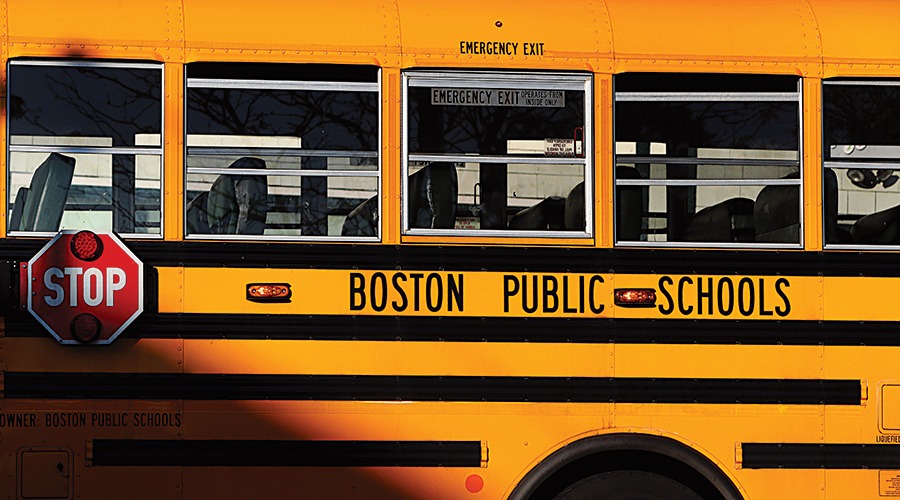
They fight against charter schools, MCAS testing, and state oversight while seeking more taxpayer money than ever before. Meanwhile, public school students’ reading and math scores are worse than they have been in 20 years. Just a coincidence? Contributing editor Jon Keller investigates.
By Jon Keller · 9/6/2023, 10:00 a.m.
Photo illustration by Benjamen Purvis
N aomi Jackson-Carter was living every parent’s worst nightmare: All five of her children were struggling in school. At the time, three of them were in need of IEPs—the individualized education programs designed for students requiring special education help—but her kids weren’t getting the resources they needed. Her son who loved history, she says, was offered “nothing whatsoever” to feed his interest. Administrators seemed indifferent, she adds, and her efforts to advocate for her kids at school were often met with pushback.
Fast-forward to 2023, and her children are thriving in school. Jackson-Carter, a Black resident of Springfield who holds a master’s degree in social work, raves about what’s been happening in all of her kids’ classrooms: “phenomenal” teachers, ample supplies, and a culture that’s “family-oriented, all about community, and all about success.” This fall, her eldest son will study engineering at Western New England University on a full scholarship, while her history-loving son is now reading at grade level after lagging well behind his peers just a couple of years ago. He loves his classroom so much, she says, that he “wants to go to school on the weekends.”
The improving performance of Jackson-Carter’s children seemingly reflects the promise of 1993’s Education Reform Act, which sought to close the appalling achievement gap between rich and poor, suburban and urban, white and non-white. Yet her kids’ success contrasts starkly with the recent performance of their public-school peers. Last year, for instance, 57 percent of fourth graders in Massachusetts’ public schools were judged not proficient in math and reading on the National Assessment of Educational Progress (NAEP) tests, the so-called Nation’s Report Card. For Black and Hispanic students specifically, the percentage judged not proficient was even greater.
So how does Jackson-Carter account for her children’s success given such dismal performance by students throughout the state? Her kids left traditional public schools for charter schools. “I will never go back to public schools,” she says. “There is no way anyone is learning in these schools.”
Jackson-Carter is hardly alone in her frustrations when it comes to public schools that are not serving students and teaching a fairly low percentage of them competency in math and reading. And unfortunately, the data backs that up. Recent reading and math scores among Massachusetts’ fourth and eighth graders are the worst they’ve been in 20 years, according to the NAEP. We remain among the nation’s top-performing states overall, but relativity is cold comfort amid a dismaying downward trend.
While some analysts are quick to blame pandemic-era school shutdowns that depressed test scores nationwide, the NAEP numbers actually show Massachusetts students’ performance has been in decline since at least 2017, well before COVID-19. Looking at the numbers, says Paul Reville, coauthor of a 1991 report entitled “Every Child a Winner” that became the blueprint for the Education Reform Act, “We’ve gotta admit, we’re nowhere near every child a winner.”
Not surprisingly, parents of school-age children are worried. In polling earlier this year by MassINC, 45 percent of Black parents and 44 percent of Hispanic parents said they were “very or somewhat concerned” about their child’s academic progress. Among white parents, 35 percent shared that same view. Meanwhile, at a recent State House hearing of reform bills by the legislature’s Joint Committee on Education, Magalie Pinney, a 52-year-old Brockton mother, broke down in tears as she lobbied for more support for programs aimed at promising students from poor households. “I believe the diverse students of Massachusetts’ residents and families are not being heard or seen or validated,” she said. “We cannot afford to lose our income streams in order to pull our kids out of public school in order to homeschool them; we don’t make enough money to place them in private schools, either. And there are thousands of us out there.” She cupped her hand over her mouth to stifle a sob, and a final plea was barely decipherable through her tears: “We need…access, opportunities, and outcomes.”
Access, opportunities, and outcomes. These have been the underlying promises of Massachusetts’ Education Reform Act, the highly touted, hugely expensive, decades-long effort to repair our broken K–12 public schools. Billions of dollars have been invested, academic standards raised, testing expanded, and alternative charter schools created to encourage innovation and put pressure on the status quo—all in pursuit of a fix for a system that the state’s highest court once ruled was “an abysmal failure…condemning generations of public school students in our poorer communities to an inferior education.”
Yet 30 years later, the money is often mismanaged, the standards have been watered down, and charter schools have been demonized by teachers unions, their growth stalled despite long waiting lists for seats. What the hell happened? How did an exceedingly rare political achievement—a well-funded, bipartisan, path-breaking effort to tackle a complex institutional problem—wind up stuck in the mud, with some of its core principles under attack and some of its most ardent proponents now unsure it’s even headed in the right direction? Why have the cheers that greeted ed reform’s early successes turned into the tears and jeers of parents such as Pinney and Jackson-Carter?
The answers are more complicated than the most draconian MCAS test question. Still, there is a common theme—accountability, or a lack of it. By districts, by politicians, and by deep-pocketed teachers unions that have accumulated massive political clout in a state dominated by Democratic politicians afraid to lose precious campaign dollars or confront their grassroots clout. Left unchecked, these unions are on a path to continue putting their political agenda and the success of their members over the success of many kids—and, in turn, are a key part of a process that is letting the futures of some of the neediest students slip away.

To critics, Governor Deval Patrick had a mixed record on education reform. / Photo via MediaNews Group/Boston Herald/Getty Images
Things didn’t always look so dire. Sixteen years ago, Massachusetts eighth graders tied with Singapore, Chinese Taipei, Japan, and the Republic of Korea for the best science scores in the world. At the time, massive increases in funding here at home had raised teacher salaries and brought new technology into many schools. The introduction of new standardized testing in 1993—a.k.a. the MCAS—helped assess whether schools and districts were meeting state standards.
Poorly performing public schools, meanwhile, had a new incentive to clean up their act: competition for students (and the state aid that followed them) from new charter schools, which were often staffed by younger teachers eager to be free of union rules that favored seniority and kept them from extending the school day. “Everyone wanted to be Massachusetts,” says Jamie Gass, director of the Center for School Reform at the right-leaning Pioneer Institute. “[Education reform] was the best thing any state did in the last 50 years.”
Then politics intervened and turned the arc of success south. In 2009, President Barack Obama’s Race to the Top program offered $4.35 billion in competitive grants to K–12 school systems willing to pursue reforms that seemed inspired by what Massachusetts had done, including setting common achievement goals and assessment programs, and expanding charter schools. Governor Deval Patrick, a staunch Obama ally, eagerly adopted the plan, including so-called Common Core standards that weren’t even required to compete for the money. Yet years later, the late former state Senate President Tom Birmingham—one of the architects of the 1993 reform—identified that decision as a disastrous blunder. “Massachusetts now settles for having similar standards and tests to Arkansas or Louisiana, whose students could not possibly meet Massachusetts’ performance levels,” he wrote in a 2018 Providence Journal article.
That’s not all Patrick did. Previously, he scrapped a key watchdog agency, the Office of Educational Quality and Accountability, as a concession, critics said, to union officials and bureaucrats embarrassed by their sometimes-unflattering audits. And while he’d campaigned in 2006 as a proponent of the innovations charter schools could provide, soon after taking office he began catering to teachers unions by echoing the rhetoric of charter school opponents on funding and expansion issues.
The watering down of Massachusetts’ original ed reform standards continued under Governor Charlie Baker, a former champion of those efforts who Gass claims “became more political” after losing his first run for governor in 2010. Once elected in 2014, for Baker, who had little power over the overwhelmingly Democratic legislature, political reality meant dealing with increasingly extreme pushback on crucial elements of ed reform from the state’s largest and most politically aggressive teachers union, the Massachusetts Teachers Association (MTA).
The saga of the MCAS test illustrates how that pushback has eroded a weight-bearing pillar of the 1993 law. At first, the MCAS was widely valued for the unprecedented detail of the data it provided on how each classroom—and every child—was doing. In other words, it provided built-in reporting. “I believe in results-based accountability, collective accountability, and collective ownership of that accountability,” says Oscar Santos, a former Boston Teacher of the Year who now heads the reformist Center for Collaborative Education. Adds Paul Toner, MTA president from 2010 to 2014, “Members appreciated the standards, appreciated MCAS as a guide.” After all, without MCAS, says Reville, also the state’s former education secretary, education reform “would be like running a business but not counting up your receipts at the end of the day.”
Yet in retrospect, the 2003 requirement that students pass the MCAS in order to graduate was a political misstep, even though a tiny percentage of students have ever been denied their diploma because of it. Many educators began to resent the test as an unwanted disruption of their work. “We’re incentivizing schools to teach to the test, narrow the curriculum,” opined UMass Lowell education professor Jack Schneider at a recent State House press conference. Not to mention how MCAS “exacerbates segregation,” he says. “Go on [real estate platforms] and see how they use ratings of schools to steer people toward particular neighborhoods.”
As the years went on, the MTA moved away from supporting the test. In 2014, Toner was succeeded as MTA president by Barbara Madeloni, a staunch MCAS critic who once dismissed grades as “meaningless” and called the Common Core standards “corporate deform.”
Today, the fight against MCAS remains a top MTA priority. With legislation on Beacon Hill and a recently filed ballot question that could come before voters in 2024, the union is going all-out to scrap the MCAS graduation requirement and add its own “performance-based assessment” system that uses a broader evaluation of students and districts. The rhetoric on MCAS from current MTA president Max Page is every bit as dismissive as Madeloni’s, accusing the state Board of Elementary and Secondary Education last year of being “obsessed with a test invented some 20 years ago and repeatedly shown to do little more than prove the wealth of a student and the community where it is taken.” He later emphasized that the union is not looking to eliminate MCAS exams altogether, just eliminate the requirement to pass for graduation: “Our fervent opposition has been to an accountability system that is high stakes.” But Mary Tamer, a former Boston School Committeewoman who now heads the state chapter of the reform advocacy group Democrats for Education Reform, says stripping the stakes from MCAS would leave Massachusetts on a short list of states with no assessments required for graduation, one of just 18.
Three decades of MCAS demonization by the union and other testing critics have taken their toll well beyond education circles. “MCAS has a bad brand,” Tamer acknowledges. But elbowing it aside in favor of the union-approved, non-standardized performance-based assessments would, she argues, neuter the state’s ability to use comparative data to spot struggling students and hold failing schools and teachers accountable. “To not measure where children are in their learning trajectory,” she says, “is just madness.”

Current Massachusetts Teachers Association president Max Page supports removing the MCAS graduation requirement.
As controversial as it is, the hot-button MCAS issue is not even the most divisive part of education reform. That unfortunate distinction belongs to charter schools, privately run, publicly funded institutions that are free to experiment with hours and instructional approaches without as much of the bureaucratic red tape and union rules that can stifle innovation and learning in conventional public schools.
The advantages of these unique schools can be profound: Stanford University’s Center for Research on Education Outcomes (CREDO) found in a recent national study that charters take on “more diverse and academically challenged students than local traditional public schools,” offer more days of reading and math instruction, and often post stronger annual student improvement. Massachusetts charters fared even better when CREDO researchers examined them in 2013; in the handful of charters the state allowed in Boston, 83 percent of their students had “significantly” more positive learning gains in math and reading than their conventional counterparts. “The average growth rate of Boston charter students in math and reading is the largest CREDO has seen in any city or state thus far,” they wrote.
The track record of charter schools was enough for Jeffrey Ned Shamon, a Charlestown father of two, to take his daughter and son out of their conventional public schools and enroll them in the Boston Collegiate Charter School. “I wasn’t an evangelist for charter schools,” Shamon, a self-described “moderate liberal Democrat,” acknowledges. But he is now. “I’m very, very pleased with the expectation level.”
Sounds great, right? There’s just one problem: With merely 78 charter schools in Massachusetts, compared with more than 1,800 conventional schools, this opportunity isn’t available to most students. Why? Because their competitors have convinced enough parents and other voters that they don’t want options.
The 1974 brainchild of a UMass Amherst professor, charters were considered cutting-edge innovation in the early 1990s and once had the backing of legendary teacher-union leader Albert Shanker as well as high-ranking Democratic politicians. Yet because charter schools aren’t required to be unionized, they are now treated as an existential threat by the MTA, despite the fact that charters enroll a mere fraction of the state’s public school students. Racist, sexist, rigid, punitive, cherry-picking predators looking to rip off the taxpayers for the benefit of wealthy investors—if there’s an egregious insult that hasn’t been flung at charter schools by union leaders and union-backed politicians, it’s not for lack of trying.
The MTA has a hard-earned reputation for muscular political activism, as demonstrated by a 2016 ballot question that brought the growth of the charter school movement to a screeching halt.
Unfortunately for the charter school movement, their increasing popularity in the state coincided with rising teacher-union political power. Among the largest donors to candidates statewide, the MTA has a hard-earned reputation for muscular political activism, as demonstrated by a 2016 ballot question that brought the growth of the charter school movement—once seen as a key part of education reform that would put competitive pressure on conventional schools to improve—to a screeching halt.
Flush with out-of-state funding, positive polling numbers, and support from the then-popular Governor Baker, charter school advocates believed the referendum—which would have allowed the state to approve up to 12 new charters or expand existing ones each year, with priority given to the worst-performing school districts—would undoubtedly succeed. But the politically street-smart MTA had what proved to be a major home-court advantage and something that the opposing side lacked: a trusted messenger. In a playbook that would be put to future use across the country, the union’s ironically named Save Our Public Schools campaign deployed rank-and-file teachers—among the most trusted and admired public servants with whom voters interact—to deliver their message at the grassroots. And they were greeted warmly. “We got such affirmation,” Concord teacher Merrie Najimy said in 2016. (At the time, she was president of her local union and would eventually become MTA president.) “This proved to teachers that we are respected, that we are the voice of authority.”
That wasn’t all: While the pro–charter schools campaign ran TV ads featuring Baker saying, “Imagine if your kids were trapped in a failing school” over footage of Black and Hispanic families, the Save Our Public Schools campaign countered with ads misleadingly claiming $400 million was being “taken away” from conventional schools by charters, accompanied in one ad by a video of students enjoying supposedly threatened music classes and science labs. “$400 million unavailable to the 96 percent of students who don’t attend charter schools,” the female narrator intoned. “Let’s improve public schools for all students, not just a select few.”
It doesn’t get much more brazen than swiping your adversary’s core message and beating them to death with it. By voting day, the partisan divide on the charter schools question was stark; only 27 percent of Democrats backed the cap lift, compared with 57 percent of Republicans, according to a post-election analysis commissioned by charter advocates. The teachers union and their allies had successfully crushed charter school advocates’ efforts in a humiliating defeat, all but eliminating the threats of competition and unflattering performance comparisons with traditional public schools.
In deep blue Massachusetts, that spelled bad news for the more than 30,000 students, most of them from low-income households, sitting on one or more charter school waiting lists. By the landslide vote of 62 to 38 percent, their chance of grabbing a coveted charter slot decreased even further.

Merrie Najimy, former president of the Massachusetts Teachers Association, opposed the expansion of charter schools in the state. / Photo via MediaNews Group/Boston Herald/Getty Images
At a June 6 meeting in the State House, the Joint Committee on Education gathered to debate one of the unfortunate topics du jour: the rolling catastrophe of literacy education in Massachusetts that has resulted in just 38 percent of fourth graders meeting or exceeding expectations in English Language Arts on the MCAS, down 10 percent since 2017. As of 2019, only one city (Washington, DC) and one state (Mississippi) were showing notable improvement in fourth-grade reading scores—and both were emphasizing phonics over largely discredited techniques, used in Massachusetts public schools, such as “three cueing,” where teachers prompt a child to guess what a word might be instead of sounding it out.
Some people want the state to compel teachers to return to techniques such as the phonics-based system. But a coalition of teachers and administrators toeing the union line has mobilized to stop it. In the education committee meeting, during which legislators considered several bills designed to promote literacy education reform, a panel of school administrators struck a common theme: allowing the state to step in and force failing districts to use literacy instruction practices that are working elsewhere would only, as Lowell literacy coordinator Melissa Newell put it, “reveal the negative impacts on learning when mandates and legislation tell individual districts what to do and use to improve literacy outcomes for students, instead of relying on the expertise in our districts.” Lisa White, Plymouth’s English Language Arts curriculum coordinator, called the proposed reforms an effort “to take away [local] control through mandates, and a narrowing of curricular and instructional options. When we limit choices, we limit students’ potential.”
Their well-coordinated message appeared to mildly stun Senate Chair of the Education Committee Jason Lewis, who cited the soul-crushing literacy data. “There are very significant disparities around income level, race, language status, and so on,” he said. “So how can you justify or defend the status quo…[when] our current system of teaching literacy is failing?”

Photo via Getty Images
There was a pregnant pause in the room. To the powers that be in the MTA and the public school establishment, arguably the most crucial players in making education reform work, the state and its taxpayers are merely a piggy bank, useful when they provide more funding but not welcome to hold them accountable for how they teach or how they spend the money. “Ed reform has a lot of different elements, some of which we fought hard for. Fundamentally, money matters in public education,” says Page, the current MTA president, who dismisses advocates of charter schools, graduation testing requirements, and phonics as “in most cases, not really friends of public education.”
For non-friends, though, the political establishment that created the ed reform law has been astonishingly generous. In 2013, two decades into ed reform, the average expenditure per pupil in Massachusetts was $14,023. By last fall, it was up to $19,062. This spring, U.S. Census data showed Boston Public Schools spent $31,397 on each student in the 2020 to 2021 school year, the highest in the nation, even as the state’s 2021 Student Opportunity Act and federal COVID-era stimulus are funneling billions more into the system.
Some districts have made good use of the help. But for Mary Tamer, the state chapter head of Democrats for Education Reform, the big question is, “Where did the money go? Did we do the best that we could have done with this funding?” She points to one underperforming elementary school in the South End, where most of the students are Black or Hispanic, which she says has only one social worker and one reading specialist despite its share of close to half a billion in federal education aid that the city received in 2021. “How is it possible we have come into all of this money,” Tamer asks, “and yet this high-needs school has seen almost nothing change?”
A scathing 2022 review of Boston Public Schools by state education officials offered some general answers. After 29 years of political emphasis on improving school management, serving the underserved, and improving the quality of learning—with many millions in new funding to back it up—investigators found gross mismanagement, inequitable access to resources, and “a lack of quality curricula and effective instructional practices.” (In order to avoid going into state receivership, Mayor Michelle Wu’s administration signed a deal with the state to collaborate on sweeping changes.)
In other words, bureaucratic incompetence abounds, fueling the overall lack of accountability that the MTA demands as its birthright. As Page acknowledges, the union keeps its eyes on the prize: the money, which it delivers to its members in spectacular fashion. National Center for Education Statistics from a few years ago show 81 percent of the more than $650 billion spent nationally on K–12 public schools go to school employee benefits and salaries; in Massachusetts, it’s 86.6 percent, the second-highest in the country. Examples around the nation of schools outperforming better-funded districts raise questions about the correlation between money and achievement, and after billions in new spending over the past three decades, it’s hard to argue the system is being shortchanged.
Still, that doesn’t deter the MTA from pushing for more. When asked to explain the faltering momentum of ed reform, Page is quick to cite the union’s chief targets: “the excessive emphasis on the testing and, until recently, leveling off of the funding.” And it has ample lobbying resources. In the 2022 election cycle alone (one in which Democratic candidates faced only a paltry slate of legitimate Republican challengers) the MTA’s political action committee doled out half a million in campaign contributions. And that money has often translated to power. If Beacon Hill balks at the union’s agenda, its leaders are ready to re-create their 2016 success with the anti-charter ballot question.

Photo via The Boston Globe/Getty Images
If education reform in Massachusetts was a remake of the 1979 movie Norma Rae, about a union organizing a worker revolt at a Dickensian textile mill, the militancy of the MTA might make more sense. But schools aren’t processing cotton. That’s why even an MTA ally like Governor Maura Healey has denounced the union’s push for teachers to have the right to strike.
Meanwhile, the ideology promoted by Page in his debut appearance before the state Board of Education—“the focus on income, on college, and career readiness speaks to a system…tied to the capitalist class and its needs for profit,” he said—seems grotesquely incompatible with the ongoing struggle of Black and Hispanic students to get the skills they need to compete. “An elitist, condescending statement,” Edith Bazile of Black Advocates for Educational Excellence told CommonWealth Magazine when describing Page’s comments. “The biggest disparity in education is how schools fail to prepare Black and brown students for college, career, and vocational success.” Page’s view is “like 1850 Karl Marx,” Paul Harrington, an economist who spent years directing the Center for Labor Market Studies at Northeastern University, told CommonWealth. “But that’s not how the real world works.”
In response, Page says his remarks “did not come out right.” While he once told the state’s board of education, “We have a fundamental difference of views of what schools are for,” he now couches the point more diplomatically: “MTA resists focusing on what job each student will get and treats them as fully engaged, healthy members of society.”
Yet out of all the accountability issues that are stalling ed reform—administrative bungling, political timidity, even negligent parents who don’t prepare their kids to succeed in school—Page’s “fundamental difference” may be the single most important problem. The union’s successful 2016 stunting of the charter school movement stifled any serious competition in the public education marketplace. The emboldened MTA now proposes to neuter the MCAS graduation requirement, a key measuring stick of teacher and administrative performance. Abandoning literacy teaching tactics that don’t work and returning to ones that do? An unacceptable imposition on their autonomy.
The spasm of disgust at Page’s Marxist diatribe is not the only sign of pushback. Healey’s Secretary of Education, veteran teacher and administrator Patrick Tutwiler, reacts to a description of MTA resistance to literacy education reform by saying, “We can’t let contention be a barrier to doing what’s right for all of our students.” And Paul Toner, the former MTA president, says the union “has to be part of the solution. They have to understand that their voice is just one of a number of voices that have a stake in the solution.”
But if the union continues to define the solution in dollars, and the dough continues to flow, what incentive does the MTA have to restore the delicate balance of power and common cause that propelled ed reform to its early successes? What real hope is there for current and future generations of families and children that start off behind the eight ball for reasons of race and class, so that parents such as Magalie Pinney can talk about education without sobbing?
One thing seems certain. “If we continue to pit each other against each other with no real results, ultimately no one wins,” says Santos of the Center for Collaborative Education. “If we keep doing the same thing, there’ll be more crying in 10 years.”
First published in the print edition of the September 2023 issue with the headline, “Are Teachers Unions Allowing Students to Fail?”